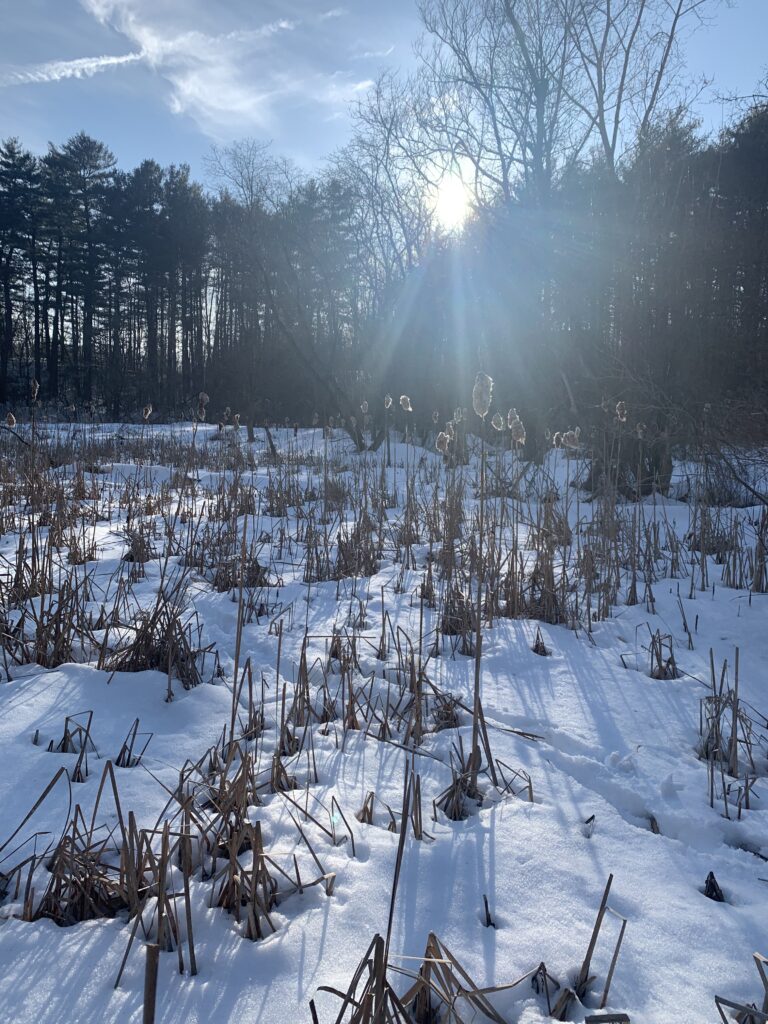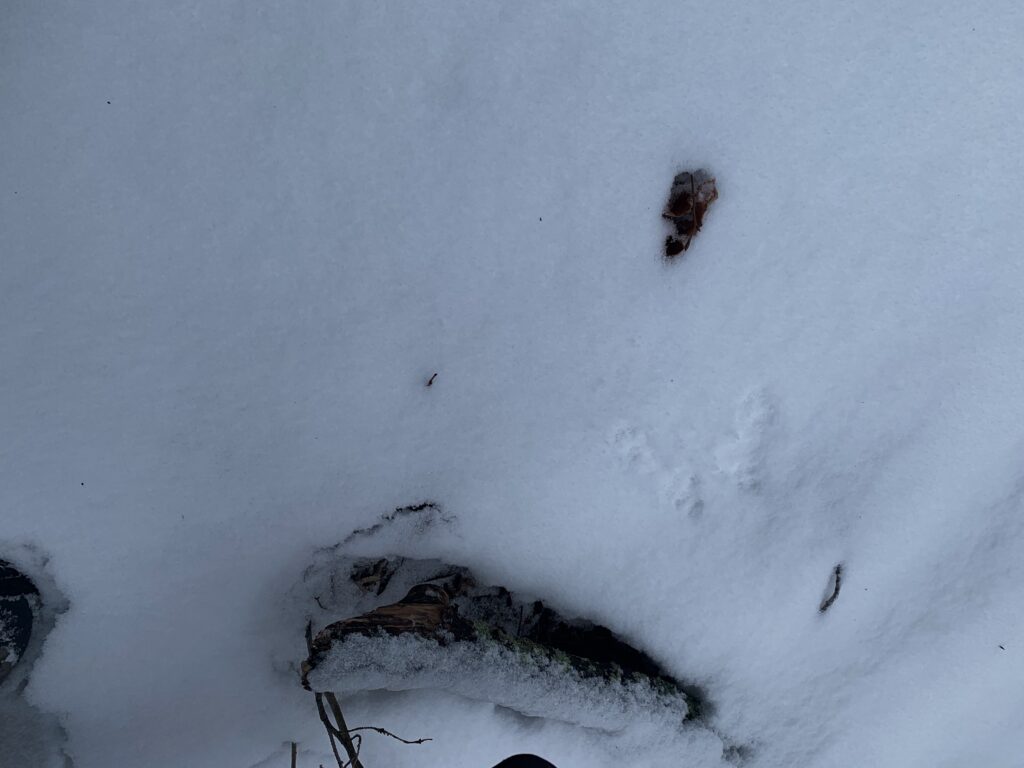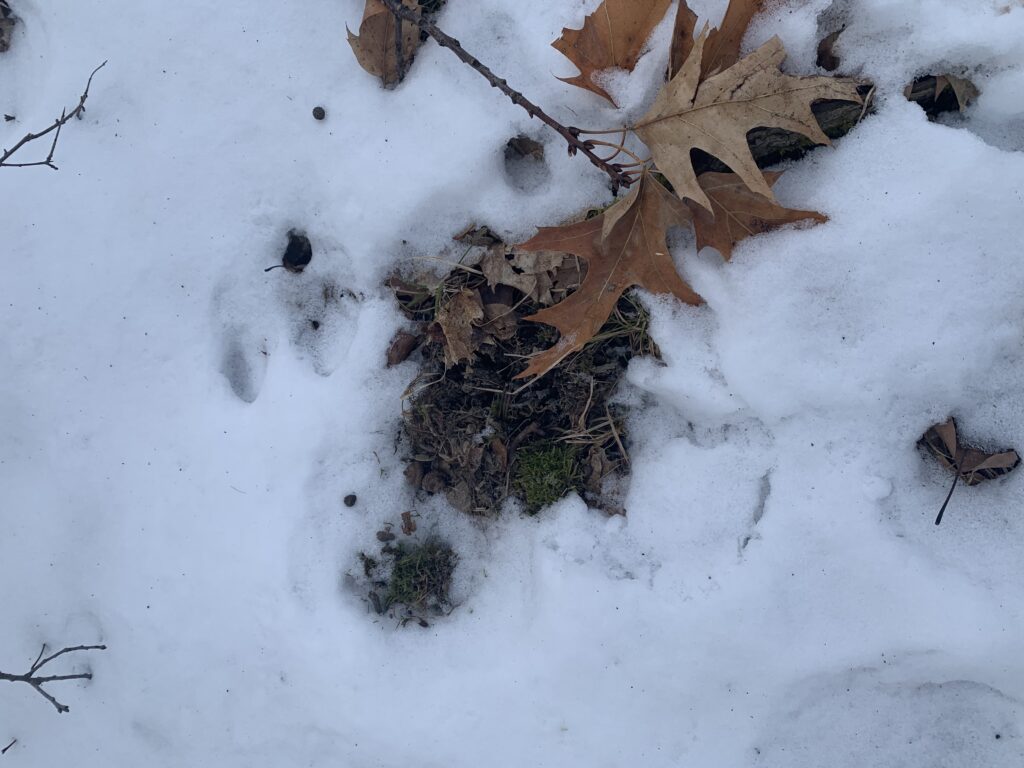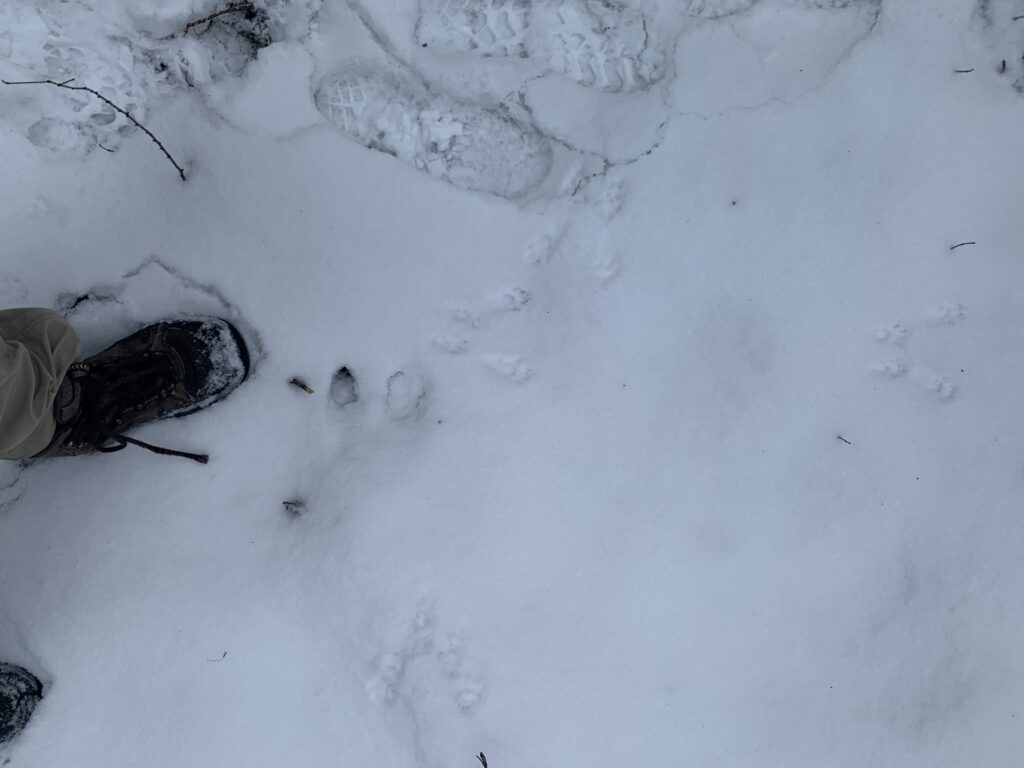The day I finally had time to trek over to my phenology spot was frigid. Unlike some of the warmer days of February, where I had finally heard the happy chirps of birds, it was silent. No animals- or people- in site. The snow was compacted and icy. Overall, not as pleasant as my phenology treks in October.

Phenological Changes:
My spot looks eerily similar to January. The trees are still barren, the ground is still covered in snow. Not a whole lot has changed. It is colder this month and felt more barren than before. But there were no new signs of growth or buds. Very similar to January.
Eastern Grey Squirrel:
Tracks are difficult to find once the snow ices over and I could only, like last time, really identify grey squirrel tracks. I was there during a particularly chilly day and saw no physical animals but was able to find scat and urine all surrounding trees with big leafy nests. The scat was dark brown and round, less than a half inch long and in clusters and the urine was reddish orange. I researched it to determine if it was blood or not and the reddish color could be from several factors: myoglobin from muscle breakdown can darken urine, oxidation, diet, and dehydration are all factors that make this normal (Rouen 2007). The scat, tracks, and urine all made it clear a grey squirrel had visited the area. I additionally found to areas the snow was dug up and covered in leaves, both believed to be food caches.

Figure 2. (2020) Tracks of eastern white squirrel, small and defined in snow spot. 
Figure 3 (2020) A squirrel Cache, leaves and dirt dug up 
Figure 4. (2020) More tracks, leading towards a Sugar Maple tree
These resilient creatures do not hibernate, instead they survive off of stored fat and their food caches. On days that are not too cold (give or take 30 degrees Fahrenheit) and are not snowing or raining, the squirrel will spend time outside foraging for food (The Pennsylvania State University 2002). Their food source consists mostly of the high protein nuts and fruit of trees like acorns. These nuts have high caloric value and store well through winter but a squirrel loses a lot of energy going to search for caches. A cache is a spot where squirrels will bury their food to store for winter. It is an innate behavior of squirrels and they may even dig fake caches if they believe a competitor is watching (The Pennsylvania State University 2002)! If they are unable to find these caches though and continue foraging, they will quickly lose fat and can easily die. Eastern grey Squirrels are diurnal, so are really only active during the day. On days that are too cold and during the night eastern grey squirrels will live in well insulated dens, often sharing them with other squirrels to stay warm in the winter (Orkin Canada 2019). Many Squirrels mate in January, and then later spring, so are currently not mating and may be developing a child. Most adult squirrels can build these dens in just one day. They are in essence twigs and leaves woven together often lined with moss, grasses, or even pine needles (Mueller 2017). February for a squirrel is about survival most. They have to be wary of birds of prey, their most prevalent predator: hawks and owls. By staying in their dens at night, grey squirrels can minimize the risk of owl attacks but hawks are a serious threat for them as well. Often in more suburban areas house-cats can actually be dangerous predators. In summary Eastern grey squirrels are just trying to get through winter alive.
Eastern grey squirrels in my phenology spot have a deep connection to the tree species: Sugar maple. While observing I noticed most of the scat and urine I found was under sugar maple trees that contained big leafy dens. These trees are a vital structure to allow the squirrels to create stable and safe homes. I did not observe nests in any other tree species in my area, probably because the sugars were the most stable. Red squirrels, a different species than I observed nut still in area, are known for actually eating the sap of these trees in late winter early spring when their caches run out. Red squirrels and grey squirrels will eat sugar maple buds and flowers, it is a vital food source for them (Holland 2015). This species is very helpful in providing survival for these creatures in the winter.
Snow in one area, further in the woods, looks littered with red blood. I did not go closer to it but it makes me wonder if it was the spot a Red tailed hawk or bird of prey could have snatched an eastern grey squirrel. This is one of their most prevalent predators in Vermont. Many red tailed hawks leave Vermont in the fall, returning in March to breed, but there are still many to be found in the empty branches of trees throughout the winter (VT Fish and Wildlife 2020). While a more common source of prey for them is smaller rodent like mice, they have been recored catching squirrels a lot. If in a tree an eastern grey squirrel may be able to maneuver around the hawks grasp and avoid being caught, but that is often not the case (Hinterland 2020). Because both red tailed hawks and eastern grey squirrels are diurnal, or active in the day, it creates a stressful predatory dynamic between the two.
Field Notes:

References:
Eastern Gray Squirrel. (n.d.). Retrieved from https://www.psu.edu/dept/nkbiology/naturetrail/speciespages/graysquirrel.htm
Eastern Grey Squirrel. (n.d.). Retrieved from https://www.hww.ca/en/wildlife/mammals/eastern-grey-squirrel.html#sid2
Holland, M. (2015, February 20). Red Squirrels & Sugar Maples. Retrieved from https://naturallycuriouswithmaryholland.wordpress.com/2015/02/20/red-squirrels-sugar-maples/
Mueller, J. (2017, November 21). Nesting Habits of Gray Squirrels. Retrieved from https://animals.mom.me/nesting-habits-gray-squirrels-3948.html
Red-Tailed Hawk. (n.d.). Retrieved from https://vtfishandwildlife.com/learn-more/vermont-critters/birds/red-tailed-hawk
Rouen. (2007, February 21). Red urine? Retrieved from https://www.homesteadingtoday.com/threads/red-urine.168350/
Where Do Squirrels Nest In Winter?: Orkin Canada. (2019, April 19). Retrieved from https://www.orkincanada.ca/blog/squirrels-in-winter/